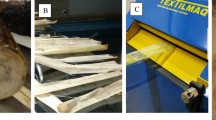Abstract
Viscose fabrics were pre-treated with liquid ammonia and NaOH solutions. The pre-treatment was varied in alkali concentration, time and drying conditions. Subsequently, the samples were subjected to cellulase hydrolysis. Microscope and SEM pictures were taken; weight loss, reducing sugar and protein content in solution, water retention value and tensile strength were determined. It was found, that the activity of cellulases is increased for viscose and that short time alkali pre-treatment reduces tensile strength due to changes in the substrate. The drying and drying conditions (wet, line dry of freeze dry) have great impact on the hydrolysis rate. A connection between the rate of protein loss in solution and changed water retention value was established. Weight loss of 80% of cellulose fabric was achieved within 4 h of enzyme hydrolysis.








Similar content being viewed by others
References
Abu-Rous M (2006a) Characterization of the wet-state pore structure of lyocell and other man-made cellulosic fibers by fluorescence and electron microscopy. PhD thesis, Leopold-Franzens-University of Innsbruck, Austria
Abu-Rous M, Ingolic E, Schuster KC (2006b) Visualization of the fibrillar and pore morphology of cellulosic fibers applying transmission electron microscopy. Cellulose 13:411–419
Bradford MM (1976) A rapid and sensitive method for the quantisation of microgram quantities of protein utilizing the principle of protein-dye binding. Anal Biochem 72:248–254
Buschle-Diller G, Zeronian SH (1994) Enzymatic and acid hydrolysis of cotton cellulose after slack and tension mercerization. Text Chem Color 26(4):17–24
Carrillo F, Colom X, López-Mesas M, Lis MJ, Gonzalez F, Valldeperas J (2003) Cellulase processing of lyocell and viscose type fibres: kinetic parameters. Proc Biochem 39:257–261
Cavaco-Paulo A (1998) Mechanism of cellulase action in textile processes. Carbohydr Polym 37:273–277
Cavaco-Paulo A, Almeida L (1996) Cellulases activity and finishing effects. Text Chem Color 28(6):28–32
Cavaco-Paulo A, Morgado J, Almeida L, Kilburn D (1998) Indigo backstaining during cellulase washing. Textile Res J 68(6):398–401
Copeland RA (2000) Chapter 7: experimental measures of enzyme activity. In: Copeland RA (ed) Enzymes: a practical introduction to structure, mechanism, and data analysis. Wiley, New York, pp 188–256
Doebel H (1999) Cellulosische Stickböden–Enzymatische Entfernung aus Luftstickereien. Textilveredlung 34(1/2):20–25
Focher B, Marzetti A, Beltrame PL, Carniti P (1991) Structural features of cellulose and cellulose derivatives, and their effects on enzymatic hydrolysis. In: Haigler CH, Weimer PJ (eds) Biosynthesis and biodegradation of cellulose. Marcel Dekker, New York, pp 293–310
Ghose TK (1987) Measurement of cellulase activities. Pure Appl Chem 59(2):257–268
Guebitz GM, Cavaco-Paulo A (2001) Editorial: biotechnology in the textile industry—perspectives for the new millennium. J Biochem 89:89–90
Heikinheimo L, Buchert J, Miettinen-Oinonen A, Souminen P (2000) Treating denim fabrics with Trichoderma reesei cellulases. Textile Res J 70(11):969–973
Jaturapiree A (2007) Porosity and transport properties in the system cellulose fiber/aqueous medium-determination and modification of porosity. PhD thesis, Leopold-Franzens-University of Innsbruck, Austria
Klahorst S, Kumar A, Mullins MM (1994) Optimizing the use of cellulase enzymes. Text Chem Color 26(2):13–18
Klemm D, Philipp B, Heinze T, Heinze U, Wagenknecht W (1998a) Comprehensive cellulose chemistry, vol 1. Fundamentals and analytical methods. Wiley, Weinheim, pp 83–100
Klemm D, Philipp B, Heinze T, Heinze U, Wagenknecht W (1998b) Comprehensive cellulose chemistry, vol 1. Fundamentals and Analytical Methods. Wiley, Weinheim, pp 150–155
Kolbes U, Hanus S, Möhring U (2003) Enzyme zur Stickgrundentfernung. Melliand Textilber 84(7/8):643
Kumar A, Harnden A (1999) Cellulase enzymes in wet processing of lyocell and its blends. Text Chem Color Am Dyest Rep 1(1):37–41
Kumar A, Purtell C, Lepola M (1994) Enzymatic treatment of man-made cellulosic fabrics. Text Chem Color 26(10):25–28
Miettinen-Oinonen A, Heikinheimo L, Buchert J, Morgado J, Almeida L, Cavaco-Paulo A (2001) The role of Trichoderma reesei cellulases in cotton finishing. AATCC Rev 1(1):33–35
Montenecourt BS (1983) Trichoderma reesei cellulases. Trends Biotechnol 1(5):156–161
Okubayashi S, Campos R, Rohrer C, Bechtold T (2005) A pilling mechanism for cellulosic knit fabrics—effect of wet processing. J Text Inst 96(1):37–41
Öztürk HB (2008) Regenerated cellulosic fibers—effect of alkali treatment on structure, chemical reactivity and fiber properties. PhD thesis, Leopold-Franzens-University of Innsbruck, Austria
Pere J, Puolakka A, Nousiainen P, Buchert J (2001) Action of purified Trichoderma reesei cellulases on cotton fibers and yarn. J Biotechnol 89:247–255
Rath H (1972) Lehrbuch der Textilchemie, 3rd edn. Springer Verlag, Berlin, pp 237–240
Schimper C, Keckeis K, Ibanescu C, Burtscher E, Manian AP, Bechtold T (2004) Influence of steam and dry heat pre-treatment on fibre properties and cellulase degradation of cellulosic fibres. Biocatal Biotransformation 22(5/6):383–389
Schimper CB, Ibanescu C, Bechtold T (2008) Advantages of a two-step enzymatic process for cotton-polyester blends. Biotechnol Lett 30(3):455–459
Tyndall RM (1992) Improving the softness and surface appearance of cotton fabrics and garments by treatment with cellulase enzymes. Text Chem Color 24(6):23–26
van Wyk JPH (1997) Cellulose hydrolysis and cellulase adsorption after pre-treatment of cellulose materials. Biotechnol Tech 11(6):443–445
Vasconcelos A, Cavaco-Paulo A (2006) Enzymatic removal of cellulose from cotton/polyester fabric blends. Cellulose 13:611–618
Wood TM, Bhat KM (1988) Methods for measuring cellulase activities. In: Wood WA, Kellog ST (eds) Methods in enzymology, vol 160. Biomass, part A: cellulose and hemicellulose. Academic Press, New York, pp 87–112
Acknowledgments
The authors wishes to thank CD-Research society for financial funding, R. Wohlgemuth and R. Schuepbach both Sigma–Aldrich Production GmbH, Buchs, Switzerland for freeze drying of the samples and providing chemicals and Lenzing A.G., Austria for material support. We are indebted to Heinz Duelli, Department of Engineering, F.H. Vorarlberg for SEM images and H.T.L. Dornbirn and Versuchsanstalt für Textil und Chemie, Dornbirn for access in testing equipment.
Author information
Authors and Affiliations
Corresponding author
Rights and permissions
About this article
Cite this article
Schimper, C.B., Ibanescu, C. & Bechtold, T. Effect of alkali pre-treatment on hydrolysis of regenerated cellulose fibers (part 1: viscose) by cellulases. Cellulose 16, 1057–1068 (2009). https://doi.org/10.1007/s10570-009-9345-6
Received:
Accepted:
Published:
Issue Date:
DOI: https://doi.org/10.1007/s10570-009-9345-6




